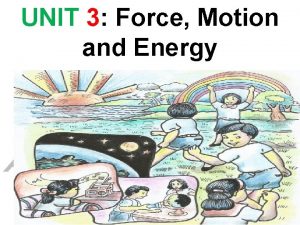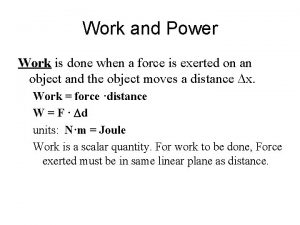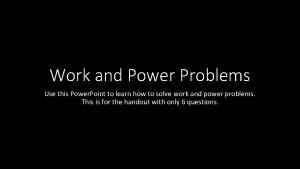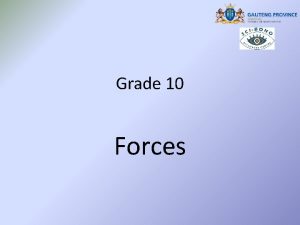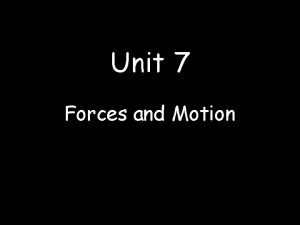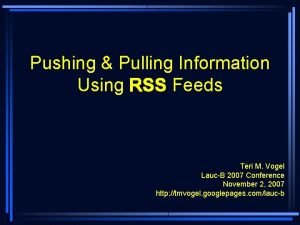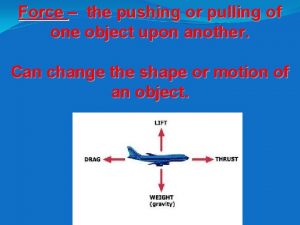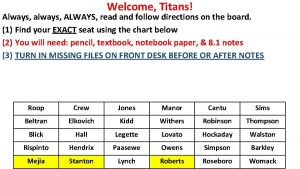Forces Always pushing and pulling What is a















- Slides: 15

Forces Always pushing and pulling!

What is a force? • A force is a push or a pull exerted by one object on another object. • Forces have both a size (strength) and a direction (like velocity and acceleration). • We measure the force of an object in Newtons (N) • One Newton is the force required to lift a quarterpound hamburger


Contact Forces • Contact forces are forces exerted only when two objects are touching each other • Friction is a force that opposes the relative motion of two objects that are in contact (Smooth surfaces have smaller friction forces than rough surfaces) • Air resistance is a force exerted by air on an object moving in the air • Buoyant force is the upward force exerted by a fluid that opposes the immersed weight of an object • Normal force

Non-contact Forces • Non-contact forces are forces exerted by one object on another when the objects are NOT touching • Gravity is the pull that every object always exerts on every other object due to their mass • The force due to gravity is called gravitational force • Electrostatic • Magnetism

Gravitational Force

Mass and Weight • Mass and weight are two different measurements • Mass is the amount of matter in you • Measured in kilograms (kg) • Does not change depending where you are • Weight is the strength of gravitational force that Earth exerts on you • Measured in Newtons (N) • We usually measure weight in pounds (lbs. ) (1 lb = 4. 4 N) • Changes depending where you are

Inertia • Objects resist having their motion changed • Inertia is the tendency of an object to resist a change in its motion • Inertia is the reason why an object at rest tends to stay at rest (Newton’s First Law of Motion) • Inertia causes moving objects to move in a straight line at a constant speed • The more mass an object has, the more inertia it has https: //www. youtube. com/watch? v=qq 1 Whusk 8 No

Inertia

Combining Forces • When more than one force acts on an object, they combine. • The combination of all the forces acting on an object is called the net force • When the forces on an object are in the same direction, they are added together • When two forces on an object are in opposite directions, the net force equals the larger force minus the smaller force


Balanced and Unbalanced Forces • When the net force on an object equals zero, the forces are balanced • When the net force on object is NOT zero, the forces are unbalanced 20 N Right 20 N Left

Balanced and Unbalanced Forces • Balances forces cause an object to stay where they are. • Unbalanced forces causes an object to move (or stop moving) • The speed of an object can change • The direction an object is moving can change

Links • https: //www. youtube. com/watch? v=-F 5 nm. IJOF 4 U

References • Google Images • Florida Science Grade 6, Glencoe Science & Mc. Graw Hill Publishing
 The forces shown above are pushing/pulling forces
The forces shown above are pushing/pulling forces The act of pushing and pulling of a magnet is called
The act of pushing and pulling of a magnet is called Biomechanics of pushing and pulling
Biomechanics of pushing and pulling Air pressure units
Air pressure units Always low prices
Always low prices Unlike parallel forces examples
Unlike parallel forces examples Contact and noncontact forces
Contact and noncontact forces Net force
Net force Constructive forces examples
Constructive forces examples Intermolecular forces vs intramolecular forces
Intermolecular forces vs intramolecular forces Interu
Interu Inter vs intramolecular forces
Inter vs intramolecular forces Sheila has just arrived at the airport and is dragging
Sheila has just arrived at the airport and is dragging Sheila has just arrived at the airport and is dragging
Sheila has just arrived at the airport and is dragging Oblique pulling spinal manipulation
Oblique pulling spinal manipulation Transitional movement assessment
Transitional movement assessment

